
Oxalis is a large genus of flowering plants in the wood-sorrel family Oxalidaceae, comprising over 550 species. The genus occurs throughout most of the world, except for the polar areas; species diversity is particularly rich in tropical Brazil, Mexico, and South Africa.
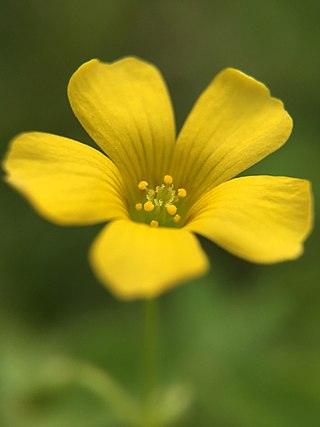
Oxalis corniculata, the creeping woodsorrel, procumbent yellow sorrel or sleeping beauty, is a somewhat delicate-appearing, low-growing herbaceous plant in the family Oxalidaceae.

Andromeda polifolia, common name bog-rosemary, is a species of flowering plant in the heath family Ericaceae, native to northern parts of the Northern Hemisphere. It is the only member of the genus Andromeda, and is only found in bogs in cold peat-accumulating areas. Andromeda glaucophylla is a synonym of A. polifolia var. latifolia.
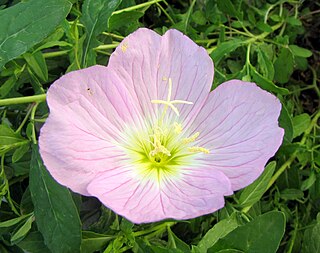
Oenothera speciosa is a species in the evening primrose family known by several common names, including pinkladies, pink evening primrose, showy evening primrose, Mexican primrose, and buttercups.

Trifolium aureum, known by the various common names large hop trefoil, large trefoil, large hop clover, golden clover or hop clover, is a species of flowering plant native to much of Eurasia.

Trifolium campestre, commonly known as hop trefoil, field clover and low hop clover, is a species of flowering plant native to Europe and western Asia, growing in dry, sandy grassland habitats, fields, woodland margins, roadsides, wastelands and cultivated land. The species name campestre means "of the fields".

Silene dioica, known as red campion and red catchfly, is a herbaceous flowering plant in the family Caryophyllaceae, native to Europe and introduced to the Americas.
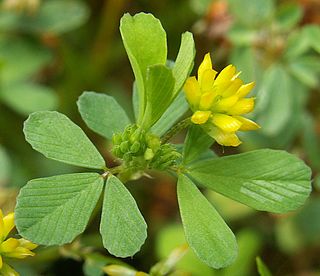
Trifolium dubium, the lesser trefoil, suckling clover, little hop clover or lesser hop trefoil, is a flowering plant in the pea and clover family Fabaceae. This species is generally accepted as the primary plant to represent the traditional Irish shamrock.

Stellaria graminea is a species of flowering plant in the family Caryophyllaceae known by the common names common starwort, grass-leaved stitchwort, lesser stitchwort and grass-like starwort.

Oxalis stricta, called the common yellow woodsorrel, common yellow oxalis, upright yellow-sorrel, lemon clover, or more ambiguously and informally "sourgrass", "juicy fruit","sheep weed", or "pickle plant", is a herbaceous plant native to North America, parts of Eurasia, and a rare introduction in Britain. It tends to grow in woodlands, meadows, and in disturbed areas as both a perennial and annual. Erect when young, this plant later becomes decumbent as it lies down, and branches regularly. It is not to be confused with similar plants in the same genus which are also often referred to as "yellow woodsorrel".

Oxalis bowiei, Bowie's wood-sorrel, red-flower woodsorrel, or Cape shamrock, is a plant from the genus Oxalis, which is native to what was Cape Province and KwaZulu-Natal in South Africa. It has also been naturalized in Australia.

Oxalis barrelieri, the Barrelier's woodsorrel, or lavender sorrel, also commonly called in French trèfle, oseille-marron, or oseille-savane, is a plant from the genus Oxalis.

Chloris virgata is a species of grass known by the common names feather fingergrassfeathery Rhodes-grass and feather windmill grass.

Oxalis incarnata is a species of flowering plant in the woodsorrel family known by the common names pale pink-sorrel and crimson woodsorrel. It is native to southern Africa, but it can be found on other continents where it is an introduced species, often the descendant of garden escapees. It is grown and kept as an ornamental plant. This is a perennial herb growing from a system of rhizomes and bulbs. The branching, hairless stem grows to nearly 30 centimeters in maximum length. There may be small bulblets located along the stem above ground. The leaves are borne on long petioles in erect bunches, each leaf made up of three leaflets. The solitary flower arises on a peduncle. Each flower has five white to light pink petals.

Silene gallica is a species of flowering plant in the family Caryophyllaceae known by several common names, including common catchfly, small-flowered catchfly, and windmill pink. It is native to Eurasia and North Africa, but it can be found throughout much of the temperate world as a common roadside weed.

Oxalis montana is a species of flowering plant in the family Oxalidaceae known by the common names mountain woodsorrel, wood shamrock, sours and white woodsorrel. It may also be called common woodsorrel, though this name also applies to its close relative, Oxalis acetosella.
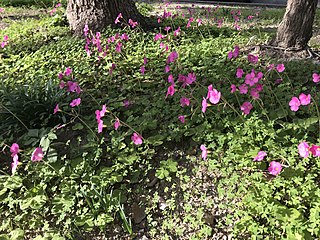
Oxalis articulata, known as pink-sorrel, pink wood sorrel, windowbox wood-sorrel, Chari amilo (Nepal), sourgrass, Netho (khatta) saag (India) is a perennial plant species in the genus Oxalis native to temperate South America. It has been introduced in Europe in gardens and is now naturalized in these areas.

Oxalis debilis, the large-flowered pink-sorrel or pink woodsorrel, is a perennial plant and herb in the family Oxalidaceae. Its original distribution is South America but has become a very cosmopolitan species, occurring in all continents except Antarctica. It can be found in both temperate and tropical areas.

Oxalis decaphylla, the ten-leaf woodsorrel, is a species of flowering plant in the family Oxalidaceae. It is native to Arizona, New Mexico, and Mexico, and it has been introduced to Great Britain. A perennial reaching 45 cm (18 in), it is found in a wide variety of damp habitats in otherwise drier areas.
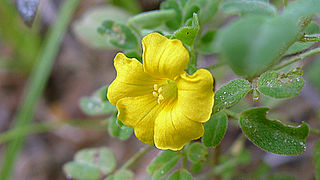
Oxalis frutescens, the shrubby woodsorrel, is a species of flowering plant in the family Oxalidaceae. It is native to New Mexico, Texas, Mexico, Central America, the southernmost Caribbean islands, and tropical South America as far as northern Argentina. A perennial subshrub reaching 35 cm (14 in), it is typically found in sandy soils in grasslands, pastures, roadsides, and open oak woodlands.


























